This is “Achieving a Healthy Diet”, chapter 2 from the book An Introduction to Nutrition (v. 1.0). For details on it (including licensing), click here.
For more information on the source of this book, or why it is available for free, please see the project's home page. You can browse or download additional books there. To download a .zip file containing this book to use offline, simply click here.
Chapter 2 Achieving a Healthy Diet
Big Idea
The dietary toolkit contains numerous ideas to help you achieve a healthy diet.
Let’s talk about a toolkit for a healthy diet. The first thing in it would be the Recommended Daily Allowances (RDAs). Then we could add the Dietary Reference Intakes (DRIs), the Estimated Average Requirements (EARs), and the Tolerable Upper Limits (ULs). All of these tools are values for important nutrients, calculated to meet the health needs of different age groups. But long before the dietary toolkit full of acronyms such as DRI, RDA, EAR, and UL, daily standards were created with the single goal of keeping workers alive and toiling in the factories and workhouses of the early Industrial Revolution. In the late nineteenth century powerhouse tycoons operated without fear of legal consequences and paid their workers as little as possible in order to maximize their own profits. Workers could barely afford housing, and depended on what their bosses fed them at the workhouses to fend off starvation.

Without programs like food stamps, workers and military personnel often had to accept whatever meager rations were given to them by their employers.
© Shutterstock
Living conditions in those days show that the term “starvation wages” was not just a figure of speech. Here’s a typical day’s menu:
- Breakfast. 1 pint porridge, one 6-ounce piece of bread.
- Lunch. Beef broth one day, boiled pork and potatoes the next.
- Dinner. 1 pint porridge, one 6-ounce piece of bread.
As public awareness about these working conditions grew, so did public indignation. Experts were eventually called in to create the first dietary guidelines, which were designed only to provide a typical individual with what they needed to survive each day, and no more. It wasn’t until World War I that the British Royal Society first made recommendations about the nutrients people needed to be healthy, as opposed to merely surviving. They included ideas we now take for granted, such as making fruit and vegetables part of the diet and giving milk to children. Since then, most governments have established their own dietary standards. Food is a precious commodity, like energy, and controlling the way it is distributed confers power. Sometimes this power is used to influence other countries, as when the United States withholds food aid from countries with regimes of which it disapproves. Governments can also use their power over food to support their most fragile citizens with food relief programs, such as the Supplemental Nutrition Assistance Program (SNAP) and the Women, Infants, and Children Supplemental Food Program (WIC).
The US government has also established dietary standards to help citizens follow a healthy diet. The first of these were the Recommended Daily Allowances (RDAs), published in 1943 because of the widespread food shortages caused by World War II. During the war, the government rationed sugar, butter, milk, cheese, eggs, coffee, and canned goods. Limited transportation made it hard to distribute fruits and vegetables. To solve this problem, the government encouraged citizens to plant “victory gardens” to produce their own fruits and vegetables. More than twenty million people began planting gardens in backyards, empty lots, and on rooftops. Neighbors pooled their resources and formed cooperatives, planting in the name of patriotism.

A key part of First Lady Michelle Obama’s healthy eating campaign is the new My Food Plate. This new icon is easier to understand than the 2005 MyPyramid, focuses on food, and can be used without a computer.
© Dreamstime
Today in the United States, there are various measures used to maintain access to nutritious, safe, and sufficient food to the citizenry. Many of these dietary guidelines are provided by the government, and are found at the Food and Drug Administration’s (FDA) new website, ChooseMyPlate.gov. We call this collection of guidelines the “dietary toolkit.”
You Decide
How will you use the dietary toolkit?
The government works to provide citizens with information, guidance, and access to healthy foods. How will you decide which information to follow? What are the elements of a healthy diet, and how do you figure out ways to incorporate them into your personal diet plan? The dietary toolkit can be likened to a mechanics toolkit, with every tool designed for a specific task(s). Likewise, there are many tools in the dietary toolkit that can help you build, fix, or maintain your diet for good health. In this chapter you will learn about many of the tools available to you.
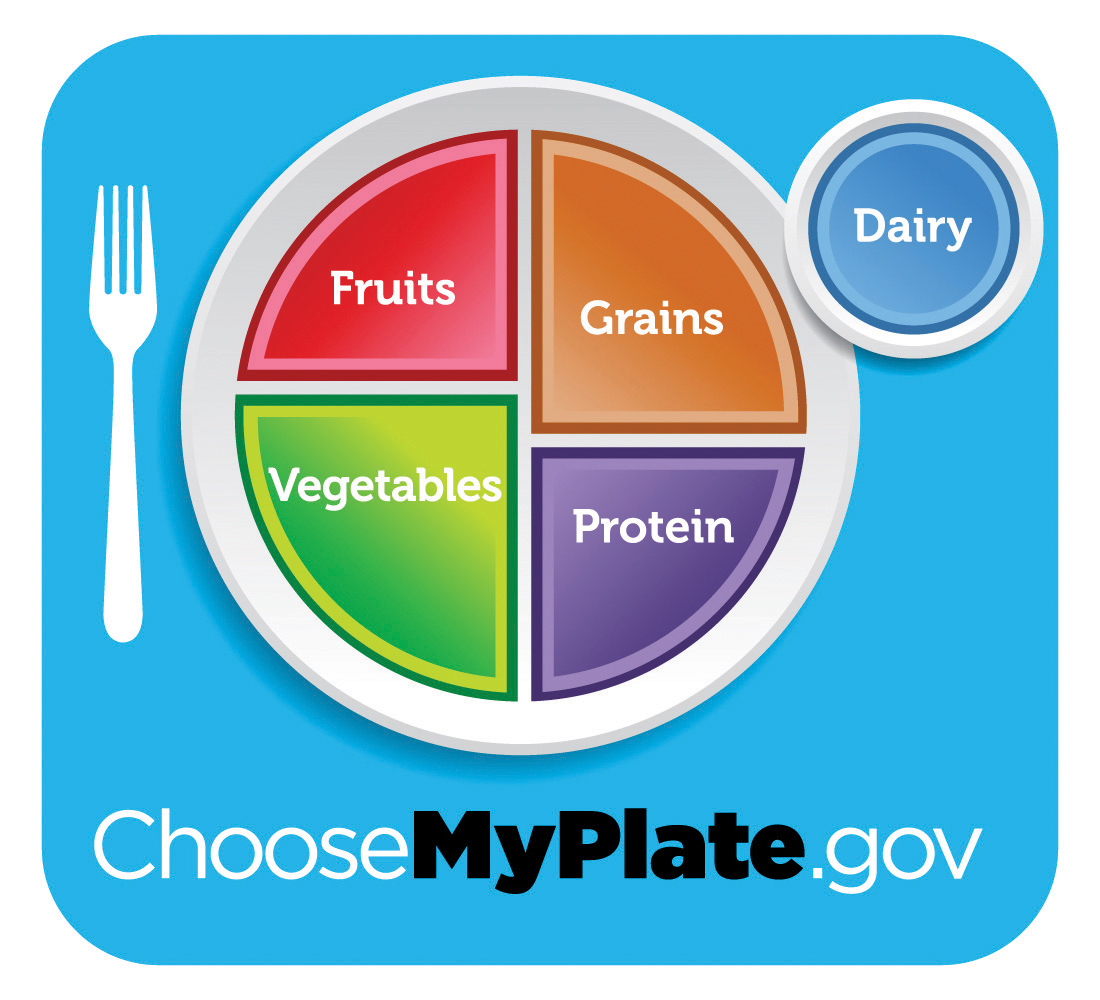
Today, the US government sets dietary guidelines that provide evidence-based nutrition information designed to improve the health of the population.
Source: US Department of Agriculture.
2.1 A Healthy Philosophy toward Food
Learning Objective
- Explain why nutrition is important to health.
“Tell me what you eat, and I will tell you what you are” wrote the French lawyer and politician, Antheime Brillat-Savarin in his book, Physiologie du Gout, ou Meditations de Gastronomie Transcendante, in 1826. Almost one hundred years later, nutritionist Victor Lindlahr wrote in an ad in 1923, “Ninety percent of the diseases known to man are caused by cheap foodstuffs. You are what you eat.” Today, we know this phrase simply as, “You are what you eat.”Phrase Finder. Accessed July 6, 2011. http://www.phrases.org.uk/meanings/you%20are%20what%20you%20eat.html
Good nutrition equates to receiving enough (but not too much) of the macronutrients (proteins, carbohydrates, fats, and water) and micronutrients (vitamins and minerals) so that the body can stay healthy, grow properly, and work effectively. The phrase “you are what you eat” refers to the fact that your body will respond to the food it receives, either good or bad. Processed, sugary, high-fat, and excessively salted foods leave the body tired and unable to perform effectively. By contrast, eating fresh, natural whole foods fuels the body by providing what it needs to produce energy, promote metabolic activity, prevent micronutrient deficiencies, ward off chronic disease, and to promote a sense of overall health and well-being.

Nutrition provides the body with the nutrients it needs to perform all activities, from taking a breath to strenuous athletic activity.
© Dreamstime
Table 2.1 Why Nutrition Is Important to Health
| Protein | Necessary for tissue formation, cell reparation, and hormone and enzyme production. It is essential for building strong muscles and a healthy immune system. |
| Carbohydrates | Provide a ready source of energy for the body and provide structural constituents for the formation of cells. |
| Fat | Provides stored energy for the body, functions as structural components of cells and also as signaling molecules for proper cellular communication. It provides insulation to vital organs and works to maintain body temperature. |
| Vitamins | Regulate body processes and promote normal body-system functions. |
| Minerals | Regulate body processes, are necessary for proper cellular function, and comprise body tissue. |
| Water | Transports essential nutrients to all body parts, transports waste products for disposal, and aids with body temperature maintenance. |
Undernutrition, Overnutrition, and Malnutrition
For many, the word “malnutrition” produces an image of a child in a third-world country with a bloated belly, and skinny arms and legs. However, this image alone is not an accurate representation of the state of malnutrition. For example, someone who is 150 pounds overweight can also be malnourished. MalnutritionA condition where one does not receive proper amounts of nutrients. This condition may have resulted from an inadequate or unbalanced diet, digestive and absorption problems, or other medical issues. refers to one not receiving proper nutrition and does not distinguish between the consequences of too many nutrients or the lack of nutrients, both of which impair overall health. UndernutritionA condition where a person is not consuming enough nutrients, which leads to malnutrition. is characterized by a lack of nutrients and insufficient energy supply, whereas overnutritionA condition where a person is consuming too much food and too many nutrients, which may lead to malnutrition. is characterized by excessive nutrient and energy intake. Overnutrition can result in obesityA metabolic disorder that leads to the overaccumulation of fat tissue, compromising overall health., a growing global health threat. Obesity is defined as a metabolic disorder that leads to an overaccumulation of fat tissue.
Although not as prevalent in America as it is in developing countries, undernutrition is not uncommon and affects many subpopulations, including the elderly, those with certain diseases, and those in poverty. Many people who live with diseases either have no appetite or may not be able to digest food properly. Some medical causes of malnutrition include cancer, inflammatory bowel syndrome, AIDS, Alzheimer’s disease, illnesses or conditions that cause chronic pain, psychiatric illnesses, such as anorexia nervosa, or as a result of side effects from medications. Overnutrition is an epidemic in the United States and is known to be a risk factor for many diseases, including Type 2 diabetes, cardiovascular disease, inflammatory disorders (such as rheumatoid arthritis), and cancer.
Growth and Development

Proper growth throughout the life stages depends upon proper nutrition.
© Dreamstime
From birth to adulthood, nutrients fuel proper growth and function of all body cells, tissue, and systems. Without proper amounts of nutrients, growth and development are stunted. Some nutrient deficiencies manifest right away, but sometimes the effects of undernutrition aren’t seen until later in life. For example, if children do not consume proper amounts of calcium and vitamin D, peak bone mass will be reduced compared to what it would be had adequate amounts of these nutrients been consumed. When adults enter old age without adequate bone mass, they are more susceptible to osteoporosis, putting them at risk for bone fractures. Therefore, it is vital to build bone strength through proper nutrition during youth because it cannot be done in later life.MedicineNet.com. “Nutrients for the Growing Years.” Last reviewed August 13, 2003. http://www.medicinenet.com/script/main/art.asp?articlekey=10054.
The Healing Process
With all wounds, from a paper cut to major surgery, the body must heal itself. Healing is facilitated through proper nutrition,MacKay, D., ND, and A. L. Miller, ND. “Nutritional Support for Wound Healing.” Alternative Medicine Review 8, no. 4 (2003): 359–77. while malnutrition inhibits and complicates this vital process. The following nutrients are important for proper healing:

Healing, a critical function of a healthy body, is facilitated by adequate nutrition.
- Vitamin A. Helps to enable the epithelial tissue (the thin outer layer of the body and the lining that protects your organs) and bone cells form.
- Vitamin C. Helps form collagen, an important protein in many body tissues.
- Protein. Facilitates tissue formation.
- Fats. Play a key role in the formation and function of cell membranes.
- Carbohydrates. Fuel cellular activity, supplying needed energy to support the inflammatory response that promotes healing.
Now that we have discussed the importance of proper nutrition for your body to perform normal tissue growth, repair, and maintenance, we will discuss ways of achieving a healthy diet.
Key Takeaways
- Nutrition promotes vitality and an overall sense of health and well-being by providing the body with energy and nutrients that fuel growth, healing, and all body systems and functions. Good nutrition will also help to ward off the development of chronic disease.
- A person is malnourished by being either undernourished or overnourished. Malnutrition results when the body does not receive the required amounts of calories, fats, proteins, carbohydrates, vitamins, and minerals necessary to keep the body and its systems in good functioning order.
Discussion Starter
- Describe what the phrase, “You are what you eat” means. Do you notice how you feel after eating certain types of foods? How might this relate to your overall health?
2.2 What Is Nutritional Balance and Moderation?
Learning Objective
- Define the components of a healthful diet.
Achieving a Healthy Diet
Achieving a healthy diet is a matter of balancing the quality and quantity of food that is eaten. There are five key factors that make up a healthful diet:
- A diet must be adequateA dietary term signifying a diet that provides all nutrients, fiber, and energy in amounts sufficient to maintaining good health and body weight., by providing sufficient amounts of each essential nutrient, as well as fiber and calories.
- A balanced dietA balanced diet supplies various types of foods in proportion to one another. With balance, foods rich in one nutrient leave room for foods that are rich in other nutrients. results when you do not consume one nutrient at the expense of another, but rather get appropriate amounts of all nutrients.
- Calorie controlControlling energy intake so that energy requirements are being met but not exceeded. is necessary so that the amount of energy you get from the nutrients you consume equals the amount of energy you expend during your day’s activities.
- ModerationNot eating to the extremes, neither too much nor too little. means not eating to the extremes, neither too much nor too little.
- VarietyConsuming an abundance of foods from different food groups on a regular basis. refers to consuming different foods from within each of the food groups on a regular basis.
A healthy diet is one that favors whole foods. As an alternative to modern processed foods, a healthy diet focuses on “real” fresh whole foods that have been sustaining people throughout the millenniums. Whole foods supply the needed vitamins, minerals, protein, carbohydrates, fats, and fiber that are essential to good health. Commercially prepared and fast foods are often lacking nutrients and often contain inordinate amounts of sugar, salt, saturated and trans fats, all of which are associated with the development of diseases such as atherosclerosis, heart disease, stroke, cancer, obesity, high cholesterol, diabetes, and other illnesses. A balanced diet is a mix of food from the different food groups (vegetables, legumes, fruits, grains, protein foods, and dairy).
Adequacy
An adequate diet is one that favors nutrient-dense foods. Nutrient-dense foodsFoods that contain many nutrients per calorie. are defined as foods that contain many essential nutrients per calorie. Nutrient-dense foods are the opposite of “empty-calorie” foods, such as sugary carbonated beverages, which are also called “nutrient-poor.” Nutrient-dense foods include fruits and vegetables, lean meats, poultry, fish, low-fat dairy products, and whole grains. Choosing more nutrient-dense foods will facilitate weight loss, while simultaneously providing all necessary nutrients.
Tools for Change
Does your diet contain nutrient-dense foods? Record your eating habits for one week. Note the sugary, fatty, and calorie-heavy foods you most often consume. Look at Table 2.2 "The Smart Choice: Nutrient-Dense Food Alternatives" to decide what you can substitute those foods with.
Table 2.2 The Smart Choice: Nutrient-Dense Food Alternatives
| Instead of… | Replace with… |
|---|---|
| Sweetened fruit yogurt | Plain fat-free yogurt with fresh fruit |
| Whole milk | Low-fat or fat-free milk |
| Cheese | Low-fat or reduced-fat cheese |
| Bacon or sausage | Canadian bacon or lean ham |
| Sweetened cereals | Minimally sweetened cereals with fresh fruit |
| Apple or berry pie | Fresh apple or berries |
| Deep-fried French fries | Oven-baked French fries or sweet potato baked fries |
| Fried vegetables | Steamed or roasted vegetables |
| Sugary sweetened soft drinks | Seltzer mixed with 100 percent fruit juice |
| Recipes that call for sugar | Experiment with reducing amount of sugar and adding spices (cinnamon, nutmeg, etc…) |
Source: US Department of Agriculture. “Food Groups.” http://www.choosemyplate.gov/food-groups/.
Balance

With careful planning, a balanced diet providing optimal nutrition can be achieved and maintained.
© Shutterstock
Balance the foods in your diet. Achieving balance in your diet entails not consuming one nutrient at the expense of another. For example, calcium is essential for healthy teeth and bones, but too much calcium will interfere with iron absorption. Most foods that are good sources of iron are poor sources of calcium, so in order to get the necessary amounts of calcium and iron from your diet, a proper balance between food choices is critical. Another example is that while sodium is a vital nutrient, an overabundance of it can contribute to congestive heart failure and chronic kidney disease. Remember, everything must be consumed in the proper amounts.
Moderation
Eat in moderation. Moderation is crucial for optimal health and survival. Burgers, French fries, cake, and ice cream each night for dinner will lead to health complications. But as part of an otherwise healthful diet and consumed only on a weekly basis, this should not have too much of an impact on overall health. If this is done once per month, it will have even less of an impact upon overall health. It’s important to remember that eating is, in part, about enjoyment and indulging with a spirit of moderation. This fits within a healthy diet.
Calorie Control
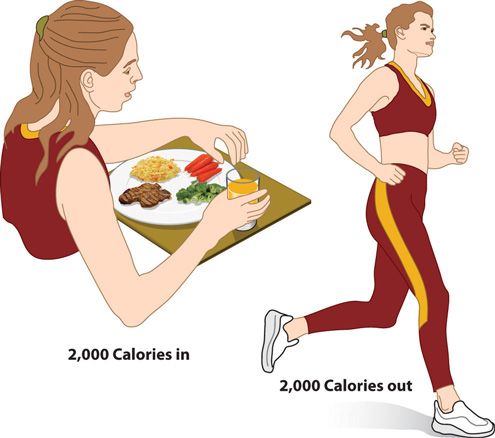
The number of calories consumed should always match the number of calories being expended by the body to maintain a healthy weight.
© Networkgraphics
Monitor food portions. For optimum weight maintenance, it is important to ensure that energy consumed from foods meets the energy expenditures required for body functions and activity. If not, the excess energy contributes to gradual, steady weight gain. In order to lose weight, you need to ensure that more calories are burned than consumed. Likewise, in order to gain weight, calories must be eaten in excess of what is expended daily.
Variety
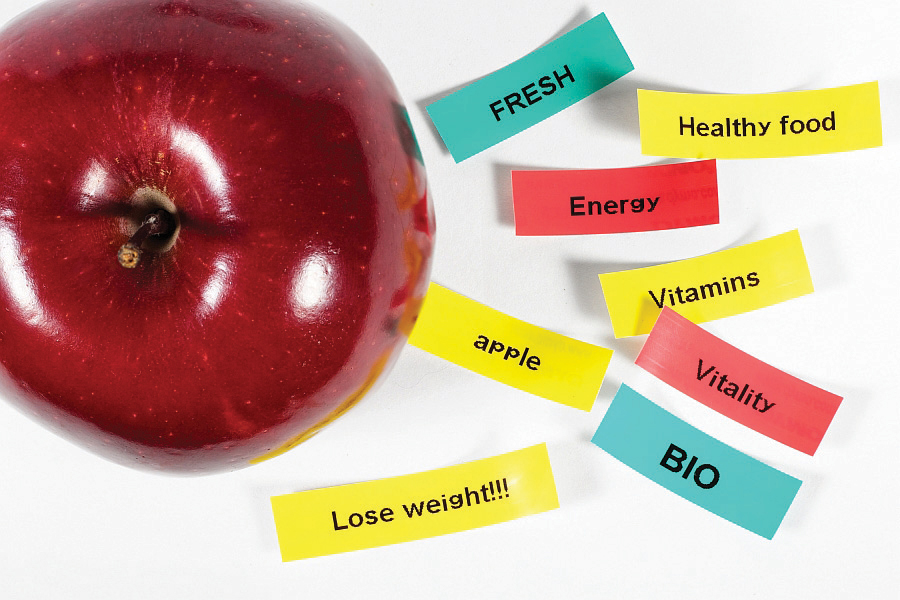
Scientific evidence confirms that a diet full of fresh whole foods reduces the risks for developing chronic disease and helps maintain a healthy weight.
© Dreamstime
Variety involves eating different foods from all the food groups. Eating a varied diet helps to ensure that you receive all the nutrients necessary for a healthy diet. One of the major drawbacks of a monotonous diet is the risk of consuming too much of some nutrients and not enough of others. Trying new foods can also be a source of pleasure—you never know what foods you might like until you try them.
Table 2.3 Food Choices for a Healthful Diet
| Grain | Vegetable | Fruit | Dairy | Protein |
|---|---|---|---|---|
| Whole-grain products, brown rice, quinoa, barley, buckwheat, millet, wild rice, oats, rye berries, sorghum, bulgur, kasha, farrow, wheat berries, corn, amaranth, spelt, Teff | Dark green: broccoli, collards, kale, romaine lettuce, spinach, turnip greens, watercress | apples, apricots, bananas | all fluid milk (fat free, low-fat, reduced-fat, whole milk, lactose-free), fortified soy milk, yogurt | Meats: beef, ham, lamb, pork, veal |
| Red and orange: Acorn squash, butternut squash, carrots, pumpkin, red peppers, sweet potatoes | Berries: strawberries, blueberries, raspberries, cherries, grapefruit, kiwi fruit, lemons, limes, mangoes | Hard natural cheeses: cheddar, mozzarella, Swiss, parmesan | Poultry: chicken, goose, turkey, duck | |
| Beans and peas: Black beans, black-eyed peas, chickpeas, kidney beans, lentils, navy beans, pinto beans, soybeans, split peas, white beans | Melons: cantaloupe, honey dew, watermelon | Soft cheeses: ricotta, cottage | Eggs | |
| Starchy: Cassava, green bananas, green peas, green lima beans, plantains, potatoes, taro, water chestnuts | Other fruits: nectarines, oranges, peaches, pears, papaya, pineapple, plums, prunes | Beans and peas: (see vegetable column) | ||
| Other vegetables: Asparagus, avocado, bean sprouts, beets, Brussels sprouts, cabbage, cauliflower, celery, eggplant, green beans, green peppers, mushrooms, okra, onions, parsnips | Nuts and seeds: almonds, cashews, hazelnuts, peanuts, pecans, pistachios, pumpkin seeds, sesame seeds, sunflower seeds, walnuts | |||
| Seafood: catfish, cod, flounder, haddock, halibut, herring, mackerel, pollock, porgy, salmon, sea bass, snapper, swordfish, trout, tuna | ||||
| Shellfish: scallops, muscles, crab, lobster |
Source: Adapted from http://www.choosemyplate.gov/food-groups/protein-foods.html.
Video Link 2.1
Different Types of Grains
In this video, a registered dietitian discusses the benefits of eating whole grains.
http://www.ehow.com/video_4983984_different-types-grains.html

Widening your food palate will increase your intake of vital nutrients.
© Dreamstime
Developing a healthful diet can be rewarding, but be mindful that all of the principles presented must be followed to derive maximal health benefits. For instance, introducing variety in your diet can still result in the consumption of too many high-calorie, nutrient-poor foods and inadequate nutrient intake if you do not also employ moderation and calorie control. Using all of these principles together will afford you lasting health benefits.
Key Takeaways
- A healthful diet is adequate in providing proper amounts of nutrient-dense foods, is balanced in relation to food types so that one nutrient is not consumed at the expense of another, practices calorie control by supplying food energy to match energy output, is moderate in unwanted constituents, and draws from a variety of nutritious foods.
- Nutrient-dense foods contribute to daily nutritional requirements while limiting caloric intake, thus allowing people to either lose weight safely or to maintain a healthy weight.
Discussion Starters
- Discuss the principles of a healthy diet. How can you employ these principles in your diet, if you are not already?
- Review the list of grains in Table 2.3 "Food Choices for a Healthful Diet". Pick one that you have not tried before. Make a dish using this grain. Discuss with your classmates your experience eating this new food.
2.3 Understanding the Bigger Picture of Dietary Guidelines
Learning Objective
- Describe the major themes of the 2010 Dietary Guidelines for Americans.
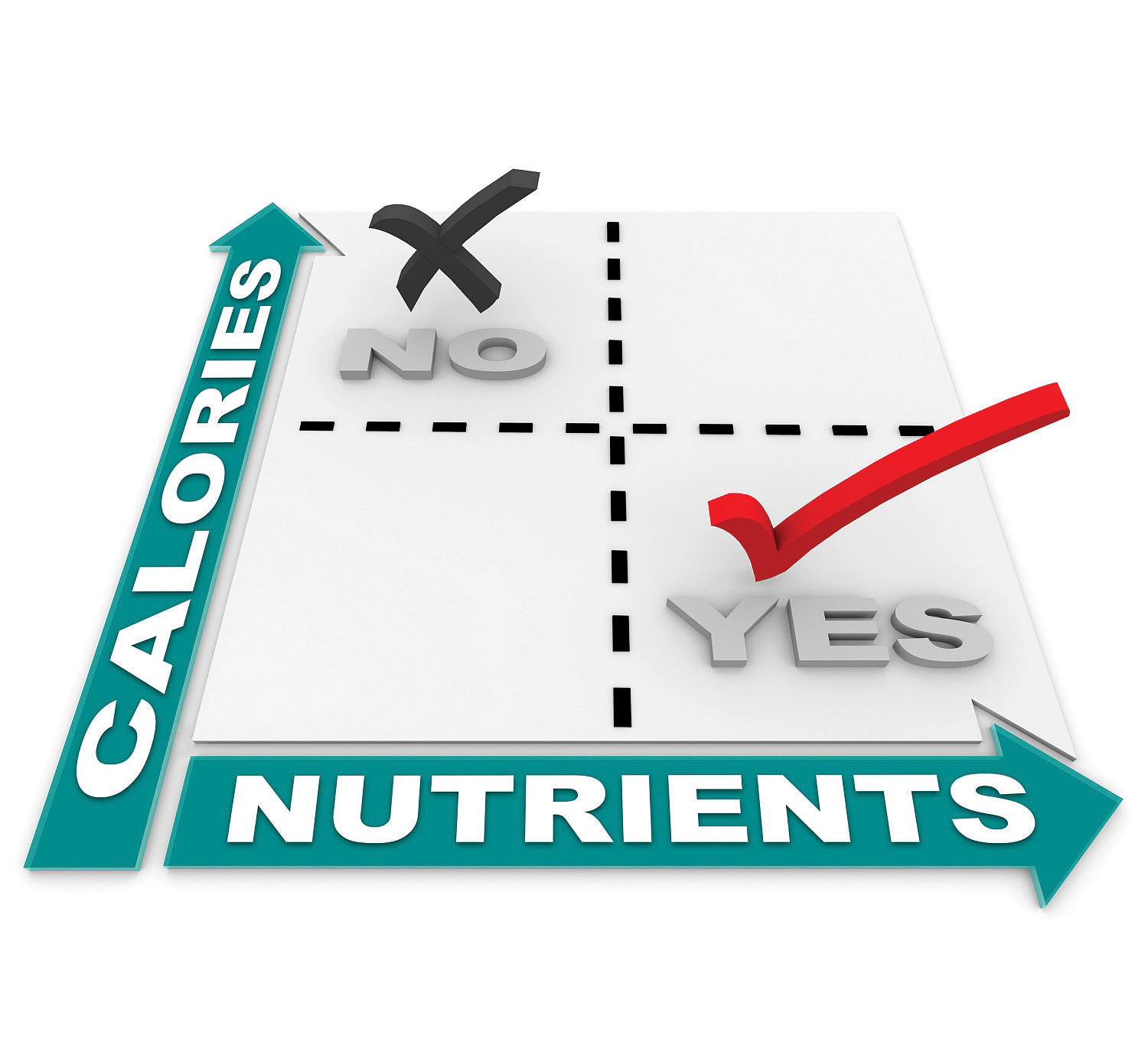
Dietary guidelines help people to stay on a healthful track by drawing attention to the overall scope of their diet and lifestyle.
© Dreamstime
The first US dietary recommendations were set by the National Academy of Sciences in 1941. The recommended dietary allowances (RDA) were first established out of concern that America’s overseas World War II troops were not consuming enough daily nutrients to maintain good health. The first Food and Nutrition Board was created in 1941, and in the same year set recommendations for the adequate intakes of caloric energy and eight essential nutrients. These were disseminated to officials responsible for food relief for armed forces and civilians supporting the war effort. Since 1980, the dietary guidelines have been reevaluated and updated every five years by the advisory committees of the US Department of Agriculture (USDA) and the US Department of Health and Human Services (HHS). The guidelines are continually revised to keep up with new scientific evidence-based conclusions on the importance of nutritional adequacy and physical activity to overall health. While dietary recommendations set prior to 1980 focused only on preventing nutrient inadequacy, the current dietary guidelines have the additional goals of promoting health, reducing chronic disease, and decreasing the prevalence of overweight and obesity.
Why Are Guidelines Needed?
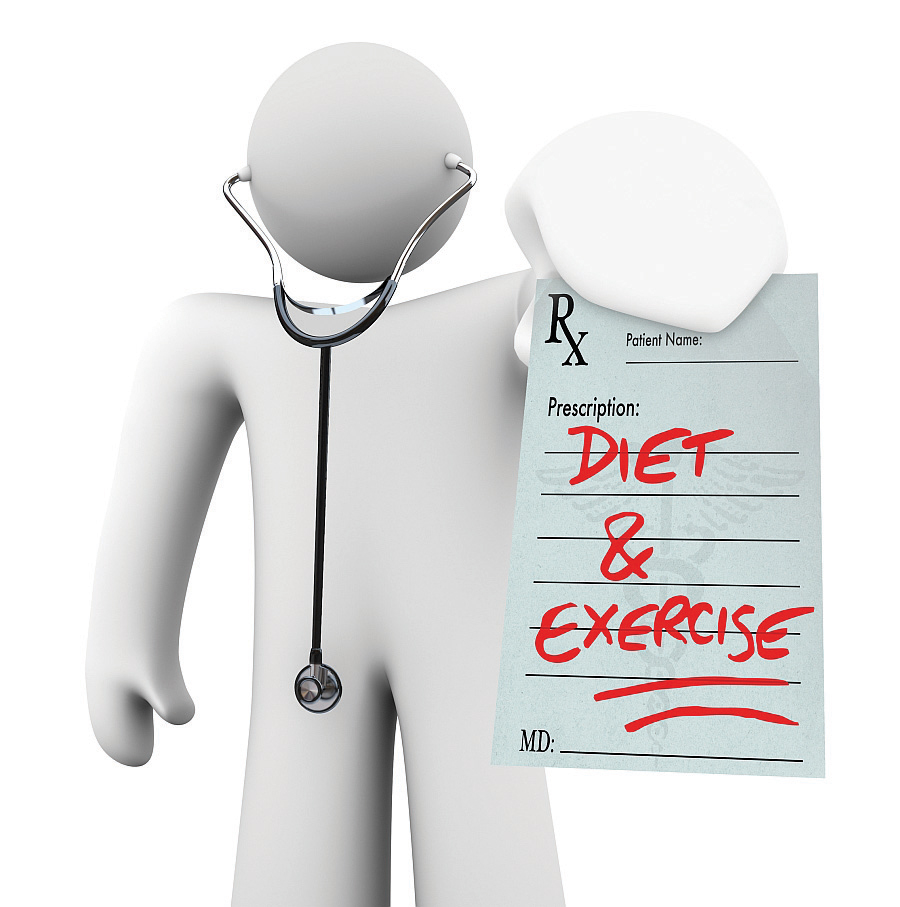
The major theme of the 2010 Dietary Guidelines for Americans is an adequate diet combined with proper exercise.
© Dreamstime
Instituting nation-wide standard policies provides consistency across organizations and allows health-care workers, nutrition educators, school boards, and elder-care facilities to improve nutrition and subsequently the health of their respective populations. At the same time, the goal of the 2010 Dietary Guidelines is to provide packaged informative guidelines that will help any interested person in obtaining optimal nutritional balance and health. The seventh edition of the Dietary Guidelines was released in 2010 and focuses mainly on combating the obesity epidemic. USDA secretary Tom Vilsack says, “The bottom line is that most Americans need to trim their waistlines to reduce the risk of developing diet-related chronic disease. Improving our eating habits is not only good for every individual and family, but also for our country.” The Dietary Guidelines are formulated by the Food and Nutrition Board of the Institute of Medicine (IOM) from the review of thousands of scientific journal articles by a consensus panel consisting of more than two thousand nutrition experts with the overall mission of improving the health of the nation.Johnson, T.D. “Online Only: New Dietary Guidelines Call for Less Salt, Fewer Calories, More Exercise.” Nation’s Health 41, no. 2 (March 2011): E6. http://thenationshealth.aphapublications.org/content/41/2/E6.full.
Major Themes of the 2010 Dietary Guidelines
The 2010 Dietary Guidelines consists of four major action steps for the American public to improve the overall health of the country. These steps are as follows:
- Reduce the incidence and prevalence of overweight and obesity of the US population by reducing overall calorie intake and increasing physical activity.
- Shift food intake patterns to a diet that emphasizes vegetables, cooked dry beans, and peas, fruits, whole grains, nuts, and seeds. In addition, increase the intake of seafood and fat-free and low-fat milk and milk products and consume only moderate amounts of lean meats, poultry, and eggs.
- Significantly reduce intake of foods containing solid fats and added sugars (SoFAS) because these dietary components contribute excess calories and few, if any, nutrients. In addition, reduce sodium intake and lower intake of refined grains that are coupled with added sugar, solid fat, and sodium.
- Meet the 2008 Physical Activity Guidelines for Americans. (http://www.cnpp.usda.gov/Publications/DietaryGuidelines/2010/PolicyDoc/Chapter1.pdf)
We will discuss the highlights of each chapter of the 2010 Dietary Guidelines; however if you are interested in reading more, visit the USDA website, http://www.cnpp.usda.gov/DGAs2010 -PolicyDocument.htm.
How should you develop a healthy eating plan to best achieve your goals of losing weight, gaining weight, or maintaining weight? We will start with some basics and move on to healthy eating patterns.
To achieve the goal of reducing caloric intake, the 2010 Dietary Guidelines promote the following:
- Increase intake of whole grains, fruits, and vegetables.
- Reduce intake of sugar-sweetened beverages.
- Monitor intake of 100 percent fruit juice for children and adolescents, especially those who are overweight or obese.
- Monitor calorie intake from alcoholic beverages for adults.
Foods and Food Components to Reduce
Table 2.4 A Little Less of These, Please
| Dietary Constituent | Health Implications | Recommendations |
|---|---|---|
| Excess sodium | High blood pressure | Limit intake to 2,300 mg daily |
| Too much saturated fat | Cardiovascular disease | Limit intake to < 10 percent of total calories |
| Trans fats | Cardiovascular disease | Minimal, if any consumption |
| Excess cholesterol | Atherosclerosis | Limit intake to below 300 mg daily |
| SoFAS (solid fats and added sugars) | Obesity, Type 2 diabetes | Avoid if possible |
| Too much alcohol | Impaired liver function, impaired motor function | No more than one drink per day for women; No more than two drinks per day for men |
High consumptions of certain foods, such as those high in saturated or trans fat, sodium, added sugars, and refined grains may contribute to the increased incidence of chronic disease. Additionally, excessive consumption of these foods replaces the intake of more nutrient-dense foods.
The average person consumes 3,400 milligrams of sodium per day, mostly in the form of table salt. The 2010 Dietary Guidelines recommend that Americans reduce their daily sodium intake to less than 2,300 milligrams. If you are over the age of fifty-one, are African American, or have cardiovascular risk factors, such as high blood pressure or diabetes, sodium intake should be reduced even further to 1,500 milligrams. The Dietary Guidelines also recommend that less than 10 percent of calories come from saturated fat, and that fat calories should be obtained by eating foods high in unsaturated fatty acids. Cholesterol intake should be decreased to below 300 milligrams per day and trans fatty acid consumption kept to a bare minimum. The Dietary Guidelines stresses the importance of limiting the consumption of foods with refined grains and added sugars, and introduce the new term, SoFASAn acronym for solid fats and added sugars., which is an acronym for solid fats and added sugars, both of which are to be avoided in a healthy diet plan.Nelson, J. and K. Zeratsky. “Dietary Guidelines Connect SoFAS and Weight Gain.” Mayo Clinic, Nutrition-Wise (blog). August 25, 2010. http://www.mayoclinic.com/health/dietary-guidelines/MY01417. Moreover, if alcohol is consumed, it should be consumed only in moderation, which for women it is not more than one drink per day and for men is not more than two drinks per day. The macronutrients protein, carbohydrates, and fats contribute considerably to total caloric intake. The IOM has made recommendations for different age groups on the percentage of total calories that should be obtained from each macronutrient class (Table 2.5 "Recommendations for Macronutrient Intake As Percentage of Total Calories").
Table 2.5 Recommendations for Macronutrient Intake As Percentage of Total Calories
| Age Group | Protein (%) | Carbohydrates (%) | Fat (%) |
|---|---|---|---|
| Children (1–3) | 5–20 | 45–65 | 30–40 |
| Children and Adolescents (4–18) | 10–30 | 45–65 | 25–35 |
| Adults (>19) | 10–35 | 45–65 | 20–35 |
Source: 2010 Dietary Guidelines.
Foods and Nutrients to Increase
The typical American diet lacks sufficient amounts of vegetables, fruits, whole grains, and high-calcium foods, causing concern for deficiencies in certain nutrients important for maintaining health. The 2010 Dietary Guidelines provide the following suggestions on food choices to achieve a healthier diet:
- Eat a variety of vegetables, especially dark green, red, and orange vegetables.
- Choose at least half of your grains consumed from whole-grain foods.
- For dairy products, eat the low-fat versions.
- Don’t get your protein only from red meats; choose instead seafood, poultry, eggs, beans, peas, nuts, seeds, and soy products.
- Replace butter with oils.
- Choose foods dense in the nutrients potassium, calcium, and vitamin D.
- Increase intake of dietary fiber.
Building Healthy Eating Patterns

Fresh vegetables and olive oil are examples of foods emphasized in the DASH and Mediterranean diets.
© Thinkstock
The 2010 Dietary Guidelines recommend that people make an effort to reduce their caloric consumption, reduce the intake of nutrient-poor foods, and increase the intake of nutrient-dense foods. To accomplish these tasks it is necessary to incorporate moderation and variety. The goal is not only choosing specific foods for your diet, but also the development of a healthy eating pattern. Several studies provide good evidence that certain dietary patterns increase overall health and decrease the risk of chronic disease. The Dietary Approaches to Stop Hypertension trial, or DASH, reports that men and women who consumed more than eight servings per day of fruits and vegetables had lower blood pressures than a control group that consumed under four servings per day of fruits and vegetables.Sacks, F.M, et al., “Effects on Blood Pressure of Reduced Dietary Sodium and the Dietary Approaches to Stop Hypertension (DASH) Diet.” N Engl J Med. 344, no. 1 (January 2001): 3–10. http://www.nejm.org/doi/full/10.1056/NEJM200101043440101. Other studies investigating the benefits of the DASH diet have also found it to be protective against cardiovascular disease and decrease overall mortality. Another well-known diet is the Mediterranean diet. In general, the Mediterranean diet is described as one that emphasizes fruits, vegetables, whole grains, and nuts, and olive oil as a replacement for butter. Few meats and high-fat dairy products are eaten. Observational studies have linked the Mediterranean diet to reduced cardiovascular disease and decreased mortality. Vegetarian diets, which emphasize many of the same foods as the DASH and Mediterranean diets have also been linked to a decrease in incidences of some chronic diseases.
Key Takeaways
- US dietary guidelines are based on evolving scientific evidence and are updated every five years. The goals of the 2010 Dietary Guidelines are to prevent nutrient inadequacy, promote health, reduce chronic disease, and decrease the prevalence of overweight and obesity.
- To have a healthy eating pattern, reduce the intake of sodium, saturated and trans fats, cholesterol, added sugars, and refined grains. Increase the consumption of fruits, vegetables, low-fat dairy products, dietary fiber, and oils.
- Healthy eating patterns prevent chronic disease and provide nutrient adequacy.
Discussion Starter
- Discuss with your classmates suggestions from the 2010 Dietary Guidelines that you should incorporate into your diet. How can you align your personal dietary goals with these recommendations?
2.4 National Goals for Nutrition and Health: Healthy People 2020
Learning Objectives
- State the Healthy People 2020 nutrition- and weight-status goals.
- List three related objectives for the Healthy People 2020 program.
The Healthy People 2020 program, launched in 2010, is a ten-year national program instituted by the US government with objectives aimed toward improving the health of all Americans. Similar to the 2010 Dietary Guidelines, it has been established to promote longer lives free of preventable disease, disability, injury, and premature death. With a revived intent on identifying, measuring, tracking, and reducing health disparities through a “determinants of health approach,” Healthy People 2020 will strive to create the social and physical environments that promote good health for all and to promote quality of life, healthy development, and healthy behaviors across all life stages. This means that the understanding of what makes and keeps people healthy is consistently refined. The determinants of health approachThese are the conditions reflective of the circumstances in which people are born, live, work, and age. It assesses the conditions that shape circumstances such as money, power, and resources at the local, national and global levels. reflects the evidence from outside factors that greatly affect the health of individuals.US Department of Health and Human Services. “About Healthy People.” Last updated March 29, 2012. http://www.healthypeople.gov/2020/about/default.aspx It takes into consideration the circumstances in which people are born, live, work, and age. It also reflects the conditions that shape their circumstances such as money, power, and resources at the local, national, and global levels. Social determinants of health are primarily accountable for the lack of fair health opportunities and the unjust differences in health status that exist within and between countries.World Health Organization. “Social Determinants of Health.” © 2012. http://www.who.int/social_determinants/en/.
Helping People Make Healthy Choices
It is not just ourselves, the food industry, and federal government that shape our choices of food and physical activity, but also our sex, genetics, disabilities, income, religion, culture, education, lifestyle, age, and environment. All of these factors must be addressed by organizations and individuals that seek to make changes in dietary habits. The socioeconomic model incorporates all of these factors and is used by health-promoting organizations, such as the USDA and the HHS to determine multiple avenues through which to promote healthy eating patterns, to increase levels of physical activity, and to reduce the risk of chronic disease for all Americans. Lower economic prosperity influences diet specifically by lowering food quality, decreasing food choices, and decreasing access to enough food. As a result of the recent financial crisis in America the number of people who struggle to have enough to eat is rising and approaching fifty million. In response to these recent numbers, USDA Secretary Tom Vilsack said, “These numbers are a wake-up call…for us to get very serious about food security and hunger, about nutrition and food safety in this country.”Amy Goldstein, “Hunger a Growing Problem in America, USDA Reports,” Washington Post, 17 November 2009. http://www.washingtonpost.com/wp-dyn/content/article/2009/11/16/AR2009111601598.html.
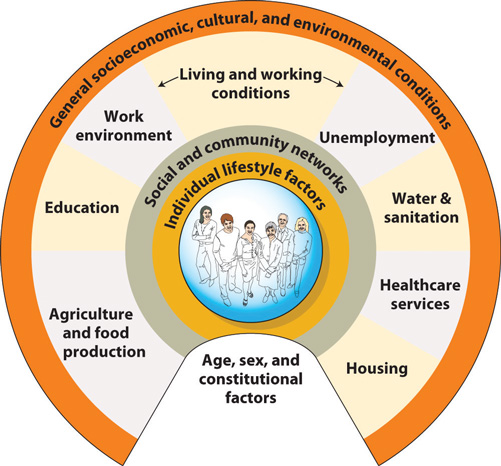
The socioeconomic model helps organizations and the government to plan and promote effective healthy-eating programs tailored to specific populations.
© Networkgraphics
Goals for Nutrition and Weight Status
While Healthy People 2020 has many goals and objectives, we are going to focus on the two goals for nutrition and weight status. They are to promote health and reduce the risk of developing chronic diseases by encouraging Americans to consume healthful diets and to achieve and maintain healthy body weights. Nutrition criteria are reflective of a solid scientific foundation for health and weight management. Emphasis is on modifying individual behavior patterns and habits, and having policies and environments that will support these behaviors in various settings, such as schools and local community-based organizations.

One of the ways that Healthy People 2020 strives to promote good health and nutrition is by bringing together multiple agencies and groups dedicated to achieving the Healthy People 2020 nationwide objectives.
© Shutterstock
Healthy People 2020 has defined their mission as:

Consuming nutrient-dense foods and limiting portion sizes of food will contribute to weight management. Avoiding excessive amounts of anything allows room for many food types in the diet.
© Dreamstime
- Identify nationwide health improvement priorities
- Increase public awareness and understanding of the determinants of health, disease, and disability, and the opportunities for progress
- Provide measurable objectives and goals that are applicable at the national, state, and local levels
- Engage multiple sectors to take actions to strengthen policies and improve practices that are driven by the best knowledge
- Identify critical research, evaluation, and data-collection needs
Healthy People 2020 has set key recommendations as follows:
- Consume a variety of nutrient-dense foods within and across the food groups, especially whole grains, fruits, vegetables, low-fat or fat-free milk or milk products, and lean meats and other protein sources
- Limit the intake of saturated fat and trans fats, cholesterol, added sugars, sodium (salt), and alcohol
- Limit caloric intake to meet caloric needsUS Department of Health and Human Services. “Nutrition and Weight Status.” HealthyPeople.gov. Last updated May 1, 2012. http://healthypeople.gov/2020/topicsobjectives2020/overview.aspx?topicid=29
Tools for Change
If you wait many hours between meals, there is a good chance you will overeat. To refrain from overeating try consuming small meals at frequent intervals throughout the day as opposed to two or three large meals. Eat until you are satisfied, not until you feel “stuffed.” Eating slowly and savoring your food allows you to both enjoy what you eat and have time to realize that you are full before you get overfull. Your stomach is about the size of your fist but it expands if you eat excessive amounts of food at one sitting. Eating smaller meals will diminish the size of your appetite over time so you will feel satisfied with smaller amounts of food.
Benefits of Following the Healthy People 2020 Goals
Nutrition and weight status are important to children’s growth and development. In addition, healthy eating habits will decrease risks for developing chronic health conditions such as obesity, malnutrition, anemia, cardiovascular disease, high blood pressure, dyslipidemia (poor lipid profiles), Type 2 diabetes, osteoporosis, dental disease, constipation, diverticular disease, and certain types of cancer.National Digestive Disease Information Clearinghouse, a service of National Institute of Diabetes and Digestive and Kidney Diseases, National Institutes of Health. “Am I at Risk for Type 2 Diabetes?” NIH Publication No. 09-4805 (November 2008). Last updated December 6, 2011. http://diabetes.niddk.nih.gov/dm/pubs/riskfortype2/.

Following the 2010 Dietary Guidelines will promote nutrition, weight loss, and weight maintenance as well as the reduction of chronic disease.
© Networkgraphics
Meeting the recommended intake for energy needs by adopting a balanced eating regimen as promoted by the USDA’s My Food Plate tool will assist people in losing and maintaining weight and in improving overall health.
Objectives Related to the Healthy People 2020 Goals
Seven out of every ten deaths in the United States are caused by chronic diseases, such as heart disease, cancer, and diabetes, and three-quarters of the country’s health spending goes toward the cost of treating these diseases. Helping people lose weight, maintain a healthy weight, and prevent chronic disease by improving dietary habits requires providing education about food and nutrition, assuring access to healthier food options, and promoting the desire and ability to become physically active. Some of the Healthy People 2020 program’s related objectives are discussed below.
- Improve health, fitness, and quality of life through daily physical activity. The Healthy People 2020 objectives for physical activity are based on the 2008 Physical Activity Guidelines for Americans, and reflect the strong scientific evidence supporting the benefits of physical activity. More than 80 percent of the current US population, from youth to adults, is not meeting these guidelines. Healthy People 2020 highlights the way that one’s level of physical activity is affected by environmental factors such as the availability of safe sidewalks, bike lanes, trails, and parks. It also highlights the legislative policies that improve access to facilities that promote physical activity. Understanding that personal, social, economic, and environmental barriers to physical activity all have a part in determining a population’s physical activity level, is an important part of being able to provide interventions that foster physical activity. Consistent physical activity is necessary for preventing chronic disease, improving bone health, decreasing body fat, and preventing an early death.
Video 2.3
Active versus Sedentary Lifestyles
(click to see video)This video provides a short overview of leading an active life versus a sedentary life.
- Increase the quality, availability, and effectiveness of educational and community-based programs designed to prevent disease and injury, improve health, and enhance quality of life. Healthy eating is a learned behavior. By increasing the number of community-based programs (schools, workplace, health-care facilities, local community groups) that offer guidance for healthy eating and lifestyle choices, people of all ages will learn good eating habits and will gain access to good food choices to help improve their diet and overall health.
- Improve the development, health, safety, and well-being of adolescents and young adults. Adolescents (ten to nineteen years of age) and young adults (twenty to twenty-four years of age) constitute 21 percent of the population of the United States. The financial burdens of preventable health problems and associated long-term costs of chronic diseases in this demographic group have the potential to be vast, and will be the result of attitudes and behaviors initiated during adolescence. For example, the annual adult health-related financial burden of cigarette smoking, which usually starts by age eighteen, is $193 billion.Adhikari, B. et al. “Smoking-Attributable Mortality, Years of Potential Life Lost, and Productivity Losses—United States, 2000–2004.” MMWR CDC Surveill Summ 57, no. 45 (November 14, 2008): 1226–8. http://www.cdc.gov/mmwr/preview/mmwrhtml/mm5745a3.htm.

Healthy children will lead to a healthy adult population with less disease, lower healthcare costs, and increased longevity.
© Shutterstock
- Reduce the consumption of calories from SoFAS in the population aged two years and older. A diet high in SoFAS contributes to excessive weight gain and poor health. Added sugars provide no nutritional value to foods. Excessive fat and sugar intake promotes tooth decay, obesity, Type 2 diabetes, unhealthy cholesterol levels, and heart disease. Being overweight increases susceptibility for developing high blood pressure, diabetes, cardiovascular diseases, and certain types of cancer. The evidence is clear that many chronic diseases are linked to unhealthy dietary patterns. Excessive consumption of SoFAS, in combination with the lack of plant-based foods, may contribute to higher rates of developing chronic diseases.
For more information on Healthy People 2020 and its related objectives for nutrition and weight status, please visit the website http://www.healthypeople.gov/2020.
Key Takeaways
- Healthy People 2020 is a health initiative with a ten-year objective of helping Americans improve health and well-being, and to live long, healthy lives. Among its many objectives are to promote health and reduce the risk of developing chronic diseases by encouraging Americans to consume healthful diets and to achieve and maintain healthy body weights.
- The goals of Healthy People 2020 are founded upon a determinants of health approach, which means they are reflective of the circumstances in which people are born, live, and work, as well as the conditions that shape their circumstances such as money, power, and resources at the local, national, and global levels. Diet patterns are influenced by genetics, environment, and cultural values. All of these things must be considered to provide the optimal approach to improving the health of the American population.
- Decreasing caloric intake and increasing physical activity are important strategies in achieving the goals of the Healthy People 2020 program.
Discussion Starters
-
Think of fun ways to increase physical activity in your life. Watch the video below for ideas.
How to Avoid a Sedentary Lifestyle
-
Review some of the Healthy People 2020 nutrition and physical activity program objectives. What objectives would you like to see enacted in your community? Why is this important to you?
2.5 Recommendations for Optimal Health
Learning Objectives
- Design a quality diet plan using MyPlate Daily Food Plan.
- State recommendation(s) for fruit and vegetable consumption and list the potential benefits of this eating program.
For many years, the US government has been encouraging Americans to develop healthful dietary habits. In 1992 the food pyramid was introduced, and in 2005 it was updated. This was the symbol of healthy eating patterns for all Americans. However, some felt it was difficult to understand, so in 2011, the pyramid was replaced with Choose MyPlate.
The Choose MyPlate program uses a tailored approach to give people the needed information to help design a healthy diet. The plate is divided according to the amount of food and nutrients you should consume for each meal. Each food group is identified with a different color, showing the food variety that all plates must have. Aside from educating people about the type of food that is best to support optimal health, the new food plan offers the advice that it is okay to enjoy food, just eat less of it.US Department of Agriculture. Accessed July 22, 2012. http://www.choosemyplate.gov/.
Video 2.4
Introducing the New Food Icon: MyPlate
(click to see video)This video provides an introduction to the new MyPlate food guide.
Building a Healthy Plate: Choose Nutrient-Rich Foods
Planning a healthy diet using the MyPlate approach is not difficult. According to the icon, half of your plate should have fruits and vegetables, one-quarter should have whole grains, and one-quarter should have protein. Dairy products should be low-fat or non-fat. The ideal diet gives you the most nutrients within the fewest calories. This means choosing nutrient-rich foods.
Fill half of your plate with red, orange, and dark green vegetables and fruits, such as kale, collard greens, tomatoes, sweet potatoes, broccoli, apples, oranges, grapes, bananas, blueberries, and strawberries in main and side dishes. Vary your choices to get the benefit of as many different vegetables and fruits as you can. You may choose to drink fruit juice as a replacement for eating fruit. (As long as the juice is 100 percent fruit juice and only half your fruit intake is replaced with juice, this is an acceptable exchange.) For snacks, eat fruits, vegetables, or unsalted nuts.
Fill a quarter of your plate with whole grains such as 100 percent whole-grain cereals, breads, crackers, rice, and pasta. Half of your daily grain intake should be whole grains. Read the ingredients list on food labels carefully to determine if a food is comprised of whole grains.
Tools for Change
Consider the information in this video:
Buying Local: The Importance of Locally Produced and Organically Grown Foods to Local Economy
Identify which vegetables and fruits are in season and local to your area. By consuming in-season, local foods you cut down on transportation costs (emission and financial) and you are likely to get fresher produce. You also support your local farms by purchasing their produce.

Make sure at least half of your daily grain intake comes from whole-grain foods.
© Shutterstock
Select a variety of protein foods to improve nutrient intake and promote health benefits. Each week, be sure to include a nice array of protein sources in your diet, such as nuts, seeds, beans, legumes, poultry, soy, and seafood. The recommended consumption amount for seafood for adults is two 4-ounce servings per week. When choosing meat, select lean cuts. Be conscious to prepare meats using little or no added saturated fat, such as butter.

Remember to vary your selections of protein. Lentils contain good amounts of protein and make great meals. Try using lentils or beans as a meat substitute each week.
© Thinkstock
If you enjoy drinking milk or eating milk products, such as cheese and yogurt, choose low-fat or nonfat products. Low-fat and nonfat products contain the same amount of calcium and other essential nutrients as whole-milk products, but with much less fat and calories. Calcium, an important mineral for your body, is also available in lactose-free and fortified soy beverage and rice beverage products. You can also get calcium in vegetables and other fortified foods and beverages.
Oils are essential for your diet as they contain valuable essential fatty acids, but the type you choose and the amount you consume is important. Be sure the oil is plant-based rather than based on animal fat. You can also get oils from many types of fish, as well as avocados, and unsalted nuts and seeds. Although oils are essential for health they do contain about 120 calories per tablespoon. It is vital to balance oil consumption with total caloric intake. The Nutrition Facts label provides the information to help you make healthful decisions.
In short, substituting vegetables and fruit in place of unhealthy foods is a good way to make a nutrient-poor diet healthy again. Vegetables are full of nutrients and antioxidants that help promote good health and reduce the risk for developing chronic diseases such as stroke, heart disease, high blood pressure, Type 2 diabetes, and certain types of cancer. Regularly eating fresh fruits and vegetables will boost your overall health profile.
Discretionary Calories
When following a balanced, healthful diet with many nutrient-dense foods, you may consume enough of your daily nutrients before you reach your daily calorie limit. The remaining calories are discretionary (to be used according to your best judgment). To find out your discretionary calorie allowance, add up all the calories you consumed to achieve the recommended nutrient intakes and then subtract this number from your recommended daily caloric allowance. For example, someone who has a recommended 2,000-calorie per day diet may eat enough nutrient-dense foods to meet requirements after consuming only 1,814 calories. The remaining 186 calories are discretionary. These calories may be obtained from eating an additional piece of fruit, adding another teaspoon of olive oil on a salad or butter on a piece of bread, adding sugar or honey to cereal, or consuming an alcoholic beverage.US Department of Agriculture. “MyPyramid Education Framework.” Accessed July 22, 2012. http://www.choosemyplate.gov
The amount of discretionary calories increases with physical activity level and decreases with age. For most physically active adults, the discretionary calorie allowance is, at most, 15 percent of the recommended caloric intake. By consuming nutrient-dense foods, you afford yourself a discretionary calorie allowance.
Table 2.6 Sample Menu Plan Containing 2,000 Calories
| Meal | Calories | Total Meal/Snack Calories |
|---|---|---|
| Breakfast | ||
| 1 scrambled egg | 92 | |
| with sliced mushrooms and spinach | 7 | |
| ½ whole-wheat muffin | 67 | |
| 1 tsp. margarine-like spread | 15 | |
| 1 orange | 65 | |
| 8 oz. low-sodium tomato juice | 53 | 299 |
| Snack | ||
| 6 oz. fat-free flavored yogurt | 100 | |
| with ½ c. raspberries | 32 | 132 |
| Lunch | ||
| 1 sandwich on pumpernickel bread | 160 | |
| with smoked turkey deli meat, | 30 | |
| 4 slices tomato | 14 | |
| 2 lettuce leaves | 3 | |
| 1 tsp. mustard | 3 | |
| 1 oz. baked potato chips | 110 | |
| ½ c. blueberries, with 1 tsp. sugar | 57 | |
| 8 oz. fat-free milk | 90 | 467 |
| Snack | ||
| 1 banana | 105 | |
| 7 reduced-fat high-fiber crackers | 120 | 225 |
| Dinner | ||
| 1 c. Greek salad (tomatoes, cucumbers, feta) | 150 | |
| with 5 Greek olives, | 45 | |
| with 1.5 tsp. olive oil | 60 | |
| 3 oz. grilled chicken breast | 150 | |
| ½ c. steamed asparagus | 20 | |
| with 1 tsp. olive oil, | 40 | |
| with 1 tsp. sesame seeds | 18 | |
| ½ c. cooked wild rice | 83 | |
| with ½ c. chopped kale | 18 | |
| 1 whole-wheat dinner roll | 4 | |
| with 1 tsp. almond butter | 33 | 691 |
| (Total calories from all meals and snacks = 1,814) | ||
| Discretionary calorie allowance: 186 | ||
Healthy Eating Index
To assess whether the American diet is conforming to the 2010 Dietary Guidelines, the Center for Nutrition Policy and Promotion (CNPP), a division of the USDA, uses a standardized tool called the Healthy Eating Index (HEI)A standardized tool based on a simple scoring system of dietary components used to assess whether the diets of Americans are improving and adhering to the dietary guidelines..US Department of Agriculture. “Healthy Eating Index.” Last modified March 14, 2012. http://www.cnpp.usda.gov/healthyeatingindex.htm. The first HEI was developed in 1995 and revised in 2006. This tool is a simple scoring system of dietary components. The data for scoring diets is taken from national surveys of particular population subgroups, such as children from low-income families or Americans over the age of sixty-five. Diets are broken down into several food categories including milk, whole fruits, dark green and orange vegetables, whole grains, and saturated fat, and then a score is given based on the amount consumed. For example, a score of ten is given if a 2,000-kilocalorie diet includes greater than 2.6 cups of milk per day. If less than 10 percent of total calories in a diet are from saturated fat, a score of eight is given. All of the scores are added up from the different food categories and the diets are given a HEI score. Using this standardized diet-assessment tool at different times, every ten years for instance, the CNPP can determine if the eating habits of certain groups of the American population are getting better or worse. The HEI tool provides the federal government with information to make policy changes to better the diets of American people. For more information on the HEI, visit this website: http://www.cnpp.usda.gov/healthyeatingindex.htm.
Key Takeaways
- The Food Pyramid has been replaced by MyPlate, a system that was designed to be easier to implement. The new MyPlate encourages all plates to be filled with fruits and vegetables (50 percent), protein (25 percent), and grains (25 percent). Half of daily grain intake should be from whole-grain sources. Dairy choices should be switched to low-fat or non-fat sources.
- A diet rich in fresh fruits and vegetables will help you lose and/or maintain weight, will lower your risk for stroke, heart disease, high blood pressure, Type 2 diabetes, and certain types of cancer, and will boost your overall health profile.
- By choosing nutrient-dense foods, you may have discretionary calories to “spend” at the end of the day.
Discussion Starter
- As you analyze the new MyPlate, how do your regular dietary habits compare to this new format? What changes, if any, will you have to make to your breakfast? Lunch? Dinner?
2.6 Understanding Daily Reference Intakes
Learning Objective
- Use the Dietary Reference Intakes to determine daily nutrient recommendations.
Dietary Reference Intakes (DRI)A set of nutrient recommendations that includes the Estimated Average Requirements (EAR), Recommended Dietary Allowances (RDA), Adequate Intakes (AI), Tolerable Upper Intake Levels (UL) and Acceptable Macronutrient Distribution Range (AMDR). are the recommendation levels for specific nutrients and consist of a number of different types of recommendations. This DRI system is used in both the United States and Canada.
Daily Reference Intakes: A Brief Overview
“Dietary Reference Intakes” (DRI) is an umbrella term for four reference values:
- Estimated Average Requirements (EAR)Average daily intake levels for nutrients estimated to meet the needs of 50 percent of the target group. Used in nutrition research and policy-making. EARs form the basis for which RDA values are set.
- Recommended Dietary Allowances (RDA)Based upon the EAR, these are nutrient-intake goals designed to meet the requirements of 97 to 98 percent of the target group for a given nutrient.
- Adequate Intakes (AI)If scientific data is insufficient to establish an EAR value, an AI is established based on the scientific data that is available. As with the RDA, the AI serves a nutrient-intake goal.
- Tolerable Upper Intake Levels (UL)The highest average daily nutrient-intake level at which a nutrient can be consumed before it poses a risk of toxicity.
The DRIs are not minimum or maximum nutritional requirements and are not intended to fit everybody. They are to be used as guides only for the majority of the healthy population.Deng, S., B. J. West, and C. J. Jensen. “A Quantitative Comparison of Phytochemical Components in Global Noni Fruits and Their Commercial Products.” Food Chemistry 122, no. 1 (September 1, 2010): 267–70. http://www.sciencedirect.com/science/article/pii/S0308814610001111.
DRIs are important not only to help the average person determine whether their intake of a particular nutrient is adequate, they are also used by health-care professionals and policy makers to determine nutritional recommendations for special groups of people who may need help reaching nutritional goals. This includes people who are participating in programs such as the Special Supplemental Food Program for Women, Infants, and Children. The DRI is not appropriate for people who are ill or malnourished, even if they were healthy previously.
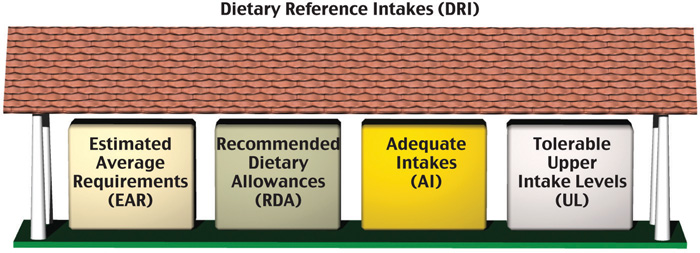
The DRIs are inclusive of all four reference values.
© Networkgraphics
Determining Dietary Reference Intakes
Each DRI value is derived in a different way. See below for an explanation of how each is determined:
- Estimated Average Requirements. The EAR for a nutrient is determined by a committee of nutrition experts who review the scientific literature to determine a value that meets the requirements of 50 percent of people in their target group within a given life stage and for a particular sex. The requirements of half of the group will fall below the EAR and the other half will be above it. It is important to note that, for each nutrient, a specific bodily function is chosen as the criterion on which to base the EAR. For example, the EAR for calcium is set using a criterion of maximizing bone health. Thus, the EAR for calcium is set at a point that will meet the needs, with respect to bone health, of half of the population. EAR values become the scientific foundation upon which RDA values are set.
- Recommended Daily Allowances. Once the EAR of a nutrient has been established, the RDA can be mathematically determined. While the EAR is set at a point that meets the needs of half the population, RDA values are set to meet the needs of the vast majority (97 to 98 percent) of the target healthy population. It is important to note that RDAs are not the same thing as individual nutritional requirements. The actual nutrient needs of a given individual will be different than the RDA. However, since we know that 97 to 98 percent of the population’s needs are met by the RDA, we can assume that if a person is consuming the RDA of a given nutrient, they are most likely meeting their nutritional need for that nutrient. The important thing to remember is that the RDA is meant as a recommendation and meeting the RDA means it is very likely that you are meeting your actual requirement for that nutrient.
Understanding the Difference
There is a distinct difference between a requirement and a recommendation. For instance, the DRI for vitamin D is a recommended 600 international units each day. However, in order to find out your true personal requirements for vitamin D, a blood test is necessary. The blood test will provide an accurate reading from which a medical professional can gauge your required daily vitamin D amounts. This may be considerably more or less than the DRI, depending on what your level actually is.
- Adequate Intake. AIs are created for nutrients when there is insufficient consistent scientific evidence to set an EAR for the entire population. As with RDAs, AIs can be used as nutrient-intake goals for a given nutrient. For example, there has not been sufficient scientific research into the particular nutritional requirements for infants. Consequently, all of the DRI values for infants are AIs derived from nutrient values in human breast milk. For older babies and children, AI values are derived from human milk coupled with data on adults. The AI is meant for a healthy target group and is not meant to be sufficient for certain at-risk groups, such as premature infants.
- Tolerable Upper Intake Levels. The UL was established to help distinguish healthful and harmful nutrient intakes. Developed in part as a response to the growing usage of dietary supplements, ULs indicate the highest level of continuous intake of a particular nutrient that may be taken without causing health problems. When a nutrient does not have any known issue if taken in excessive doses, it is not assigned a UL. However, even when a nutrient does not have a UL it is not necessarily safe to consume in large amounts.
Figure 2.1 DRI Graph
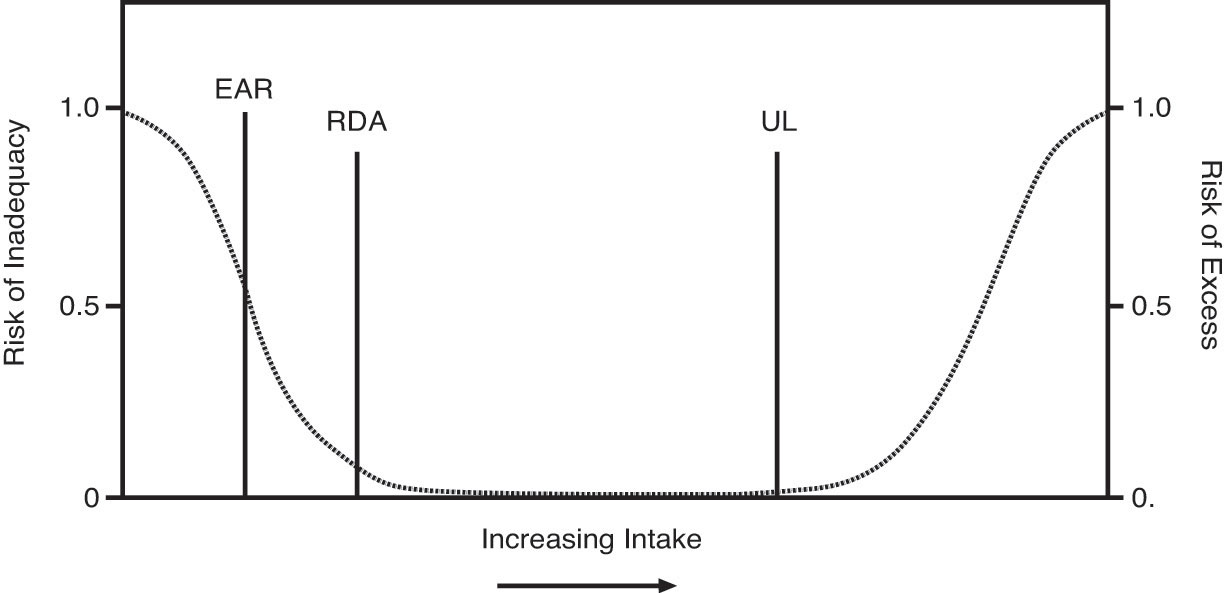
This graph illustrates the risks of nutrient inadequacy and nutrient excess as we move from a low intake of a nutrient to a high intake. Starting on the left side of the graph, you can see that when you have a very low intake of a nutrient, your risk of nutrient deficiency is high. As your nutrient intake increases, the chances that you will be deficient in that nutrient decrease. The point at which 50 percent of the population meets their nutrient need is the EAR, and the point at which 97 to 98 percent of the population meets their needs is the RDA. The UL is the highest level at which you can consume a nutrient without it being too much—as nutrient intake increases beyond the UL, the risk of health problems resulting from that nutrient increases.
Source: Institute of Medicine. © 2012 National Academy of Sciences. All Rights Reserved. http://www.iom.edu.
- Acceptable Macronutrient Distribution Ranges. The Acceptable Macronutrient Distribution Range (AMDR)The value of the energy-yielding nutrients carbohydrates, protein, and fat, expressed as percentages of total daily calorie intake, sufficient to provide total adequate energy needs; staying within the AMDR is associated with reducing the risks for developing chronic disease. is the calculated range of how much energy from carbohydrates, fats, and protein is recommended for a healthy diet. People who do not reach the AMDRs for their target group increase their risk of developing health complications. See Chapter 10 "Nutrients Important for Metabolism and Blood Function" for more information on calculating requirements.
Table 2.7 AMDR Values for Adults
| Nutrient | Value (percentage of Calories) |
|---|---|
| Fat | 20.0–35.0 |
| Carbohydrate | 45.0–65.0 |
| Protein | 10.0–35.0 |
| Polyunsaturated fatty acids | 5.0–10.0 |
| Linolenic acid | 0.6–1.2 |
Source: Food and Nutrition Board of the Institute of Medicine. Dietary Reference Intakes for Energy, Carbohydrate, Fiber, Fat, Fatty Acids, Cholesterol, Protein, and Amino Acids. (Washington, DC: National Academies Press, 2002).
Tips for Using the Dietary Reference Intakes to Plan Your Diet
You can use the DRIs to help assess and plan your diet. Keep in mind when evaluating your nutritional intake that the values established have been devised with an ample safety margin and should be used as guidance for optimal intakes. Also, the values are meant to assess and plan average intake over time; that is, you don’t need to meet these recommendations every single day—meeting them on average over several days is sufficient.
Key Takeaways
- Nutrient-intake recommendations set for healthy people living in the United States and Canada are known as Dietary Reference Intakes.
- The DRIs includes the AI, EAR, RDA, and UL for micronutrients and the AMDR ranges for energy-yielding macronutrients. The DRI provide a set of standards for researchers and government policy-makers, and specifies nutrient consumption guidelines for individuals.
Discussion Starter
- Why do you think it is important for the government to set the DRI standards? How will you use this information for your personal dietary choices?
2.7 Discovering Nutrition Facts
Learning Objective
- Use the Nutrition Facts panel to discover the nutritional information of food.
The Labels on Your Food
Understanding the significance of dietary guidelines and how to use DRIs in planning your nutrient intakes can make you better equipped to select the right foods the next time you go to the supermarket.
In the United States, the Nutrition Labeling and Education Act passed in 1990 and came into effect in 1994. In Canada, mandatory labeling came into effect in 2005. As a result, all packaged foods sold in the United States and Canada must have nutrition labels that accurately reflect the contents of the food products. There are several mandated nutrients and some optional ones that manufacturers or packagers include. Table 2.8 "Mandatory and Optional Inclusions on Nutrition Labels" lists the mandatory and optional inclusions.
Table 2.8 Mandatory and Optional Inclusions on Nutrition Labels
| Mandatory Inclusion | Optional Inclusion |
|---|---|
| Total Calories | Calories from saturated fats |
| Calories from fat | Polyunsaturated fat |
| Total fat | Monounsaturated fat |
| Saturated fat | Potassium |
| Cholesterol | Soluble fiber |
| Total carbohydrates | Sugar alcohol |
| Dietary fiber | Other carbohydrates |
| Sugars | Percent of vitamin A present as beta-carotene |
| Vitamins A and C | Other essential vitamins and minerals |
| Calcium | |
| Iron |
Source: US Food and Drug Administration. “Food Labeling Guide.” Last updated February 10, 2012. http://www.fda.gov.
There are other types of information that are required by law to appear somewhere on the consumer packaging. They include:
- Name and address of the manufacturer, packager, or distributor
- Statement of identity, what the product actually is
- Net contents of the package: weight, volume, measure, or numerical count
- Ingredients, listed in descending order by weight
- Nutrient information of serving size and daily valuesUS Food and Drug Administration. “Food Labeling.” http://www.fda.gov/Food/GuidanceComplianceRegulatoryInformation/GuidanceDocuments/FoodLabelingNutrition/FoodLabelingGuide/default.htm
The Nutrition Facts panelFound on most packaged foods, it contains specific amounts of nutrients and also compares the amounts of nutrients in the food and the recommended intake values. These comparisons are reported as percent DV. provides a wealth of information about the nutritional content of the product. The information also allows shoppers to compare products. Because the serving sizes are included on the label, you can see how much of each nutrient is in each serving to make the comparisons. Knowing how to read the label is important because of the way some foods are presented. For example, a bag of peanuts at the grocery store may seem like a healthy snack to eat on the way to class. But have a look at that label. Does it contain one serving, or multiple servings? Unless you are buying the individual serving packages, chances are the bag you picked up is at least eight servings, if not more.
According to the 2010 health and diet survey released by the FDA, 54 percent of first-time buyers of a product will check the food label and will use this information to evaluate fat, calorie, vitamin, and sodium content.US Food and Drug Administration. “Survey Shows Gain in Food-Label Use, Health/Diet Awareness.” March 2, 2010. http://www.fda.gov/ForConsumers/ConsumerUpdates/ucm202611.htm#FoodLabelHighlights. The survey also notes that more Americans are using food labels and are showing an increased awareness of the connection between diet and health. Having reliable food labels is a top priority of the FDA, which has a new initiative to prepare guidelines for the food industry to construct “front of package” labeling that will make it even easier for Americans to choose healthy foods. Stay tuned for the newest on food labeling by visiting the FDA website: http://www.fda.gov/Food/LabelingNutrition/default.htm.
Video Link 2.2
The Food Label and You
The FDA has prepared a new video about nutrition labeling that is packed with helpful information. You can watch the full-length video or individual segments.
http://www.fda.gov/Food/ResourcesForYou/Consumers/NFLPM/default.htm
Reading the Label
The first part of the Nutrition Facts panel gives you information on the serving size and how many servings are in the container. For example, a label on a box of crackers might tell you that twenty crackers equals one serving and that the whole box contains 10 servings. All other values listed thereafter, from the calories to the dietary fiber, are based on this one serving. On the panel, the serving size is followed by the number of calories and then a list of selected nutrients. You will also see “Percent Daily Value” on the far right-hand side. This helps you determine if the food is a good source of a particular nutrient or not. The Daily Value (DV)Based upon the RDI of a specific nutrient in a 2,000 kilocalorie diet. represents the recommended amount of a given nutrient based on the RDI of that nutrient in a 2,000-kilocalorie diet (Figure 2.2 "Determining Your Nutrient Allowances per Day"). The percentage of Daily Value (percent DV)The percentage of the amount of the nutrient in relationship to the DV. They are applicable only for a 2,000-calorie daily diet (not 2,500 calories). represents the proportion of the total daily recommended amount that you will get from one serving of the food. For example, in the food label in Figure 2.2 "Determining Your Nutrient Allowances per Day", the percent DV of calcium for one serving of macaroni-and-cheese is 20 percent, which means that one serving of macaroni and cheese provides 20 percent of the daily recommended calcium intake. Since the DV for calcium is 1,000 milligrams, the food producer determined the percent DV for calcium by taking the calcium content in milligrams in each serving, and dividing it by 1,000 milligrams, and then multiplying it by 100 to get it into percentage format. Whether you consume 2,000 calories per day or not you can still use the percent DV as a target reference.
Generally, a percent DV of 5 is considered low and a percent DV of 20 is considered high. This means, as a general rule, for fat, saturated fat, trans fat, cholesterol, or sodium, look for foods with a low percent DV. Alternatively, when concentrating on essential mineral or vitamin intake, look for a high percent DV. To figure out your fat allowance remaining for the day after consuming one serving of macaroni-and-cheese, look at the percent DV for fat, which is 18 percent, and subtract it from 100 percent. To know this amount in grams of fat, read the footnote of the food label to find that the recommended maximum amount of fat grams to consume per day for a 2,000 kilocalories per day diet is 65 grams. Eighteen percent of sixty-five equals about 12 grams. This means that 53 grams of fat are remaining in your fat allowance. Remember, to have a healthy diet the recommendation is to eat less than this amount of fat grams per day, especially if you want to lose weight.
Table 2.9 DVs Based on a Caloric Intake of 2,000 Calories (For Adults and Children Four or More Years of Age)
| Food Component | DV |
|---|---|
| Total fat | 65 g |
| Saturated fat | 20 g |
| Cholesterol | 300 mg |
| Sodium | 2,400 mg |
| Potassium | 3,500 mg |
| Total carbohydrate | 300 g |
| Dietary fiber | 25 g |
| Protein | 50 g |
| Vitamin A | 5,000 IU |
| Vitamin C | 60 mg |
| Calcium | 1,000 mg |
| Iron | 18 mg |
| Vitamin D | 400 IU |
| Vitamin E | 30 IU |
| Vitamin K | 80 micrograms µg |
| Thiamin | 1.5 mg |
| Riboflavin | 1.7 mg |
| Niacin | 20 mg |
| Vitamin B6 | 2 mg |
| Folate | 400 µg |
| Vitamin B12 | 6 µg |
| Biotin | 300 µg |
| Pantothenic acid | 10 mg |
| Phosphorus | 1,000 mg |
| Iodine | 150 µg |
| Magnesium | 400 mg |
| Zinc | 15 mg |
| Selenium | 70 µg |
| Copper | 2 mg |
| Manganese | 2 mg |
| Chromium | 120 µg |
| Molybdenum | 75 µg |
| Chloride | 3,400 mg |
Figure 2.2 Determining Your Nutrient Allowances per Day
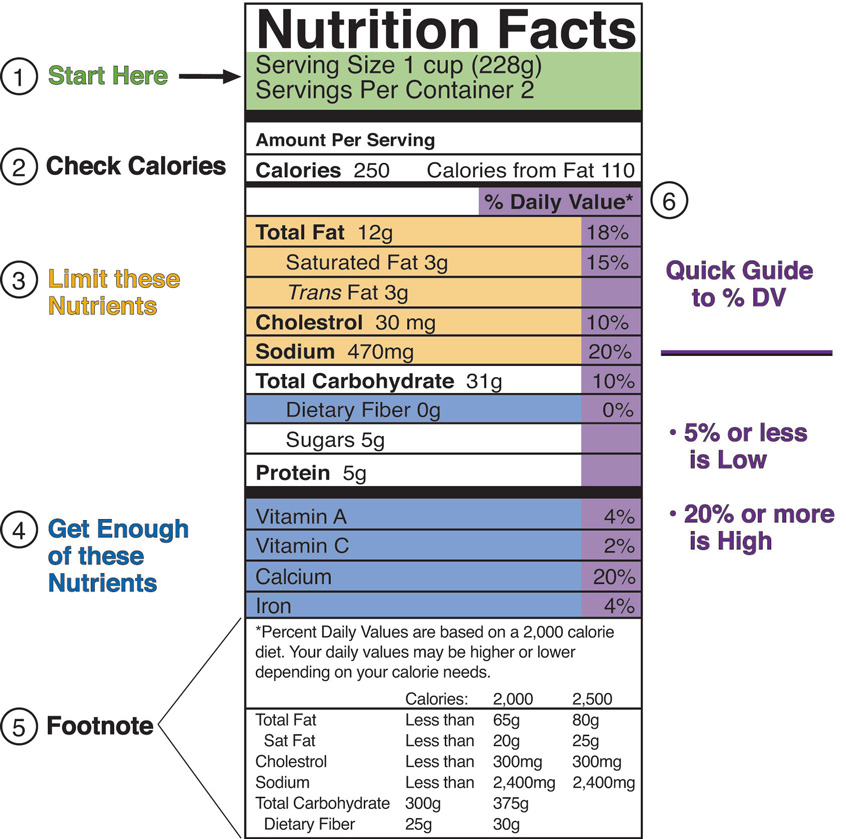
Pictured here is a sample label for macaroni and cheese.
Source: FDA. “How to Understand and Use the Nutrition Facts Panel.” Last updated February 15, 2012. http://www.fda.gov/food/labelingnutrition/consumerinformation/ucm078889.htm#dvs
Of course, this is a lot of information to put on a label and some products are too small to accommodate it all. In the case of small packages, such as small containers of yogurt, candy, or fruit bars, permission has been granted to use an abbreviated version of the Nutrition Facts panel. To learn additional details about all of the information contained within the Nutrition Facts panel, see the following website: http://www.fda.gov/Food/ResourcesForYou/Consumers/NFLPM/ucm274593.htm
Video Link 2.3
How to Read Food Labels
Pay attention to the fine print when grocery shopping.
http://videos.howstuffworks.com/fit-tv/14212-diet-doctor-how-to-read-food-labels-video.htm
Claims on Labels
In addition to mandating nutrients and ingredients that must appear on food labels, any nutrient-content claims must meet certain requirements. For example, a manufacturer cannot claim that a food is fat-free or low-fat if it is not, in reality, fat-free or low-fat. Low-fat indicates that the product has three or fewer grams of fat; low salt indicates there are fewer than 140 milligrams of sodium, and low-cholesterol indicates there are fewer than 20 milligrams of cholesterol and two grams of saturated fat. See Table 2.10 "Common Label Terms Defined" for some examples.US Food and Drug Administration. “Additional Requirements for Nutrient Content Claims.” Appendix B in Food Labeling Guide (October 2009). http://www.fda.gov/Food/GuidanceComplianceRegulatoryInformation/GuidanceDocuments/FoodLabelingNutrition/FoodLabelingGuide/ucm064916.htm.
Table 2.10 Common Label Terms Defined
| Term | Explanation |
|---|---|
| Lean | Fewer than a set amount of grams of fat for that particular cut of meat |
| High | Contains more than 20% of the nutrient’s DV |
| Good source | Contains 10 to 19% of nutrient’s DV |
| Light/lite | Contains ⅓ fewer calories or 50% less fat; if more than half of calories come from fat, then fat content must be reduced by 50% or more |
| Organic | Contains 95% organic ingredients |
Source: US Food and Drug Administration. “Food Labeling Guide.” Last updated February 10, 2012. http://www.fda.gov.
Health Claims
Often we hear news of a particular nutrient or food product that contributes to our health or may prevent disease. A health claim is a statement that links a particular food with a reduced risk of developing disease. As such, health claims such as “reduces heart disease,” must be evaluated by the FDA before it may appear on packaging. Prior to the passage of the NLEA products that made such claims were categorized as drugs and not food. All health claims must be substantiated by scientific evidence in order for it to be approved and put on a food label. To avoid having companies making false claims, laws also regulate how health claims are presented on food packaging. In addition to the claim being backed up by scientific evidence, it may never claim to cure or treat the disease. For a detailed list of approved health claims, visit: http://www.fda.gov/Food/LabelingNutrition/LabelClaims/HealthClaimsMeeting SignificantScientificAgreementSSA/default.htm#Approved_Health_Claims.
Qualified Health Claims
While health claims must be backed up by hard scientific evidence, qualified health claims have supportive evidence, which is not as definitive as with health claims. The evidence may suggest that the food or nutrient is beneficial. Wording for this type of claim may look like this: “Supportive but not conclusive research shows that consumption of EPA and DHA omega-3 fatty acids may reduce the risk of coronary artery disease. One serving of [name of food] provides [X] grams of EPA and DHA omega-3 fatty acids. [See nutrition information for total fat, saturated fat, and cholesterol content.]US Food and Drug Administration. “FDA Announces Qualified Health Claims for Omega-3 Fatty Acids.” September 8, 2004. http://www.fda.gov/SiteIndex/ucm108351.htm.
Structure/Function Claims
Some companies claim that certain foods and nutrients have benefits for health even though no scientific evidence exists. In these cases, food labels are permitted to claim that you may benefit from the food because it may boost your immune system, for example. There may not be claims of diagnosis, cures, treatment, or disease prevention, and there must be a disclaimer that the FDA has not evaluated the claim.US Food and Drug Administration. “Claims That Can Be Made for Conventional Foods and Dietary Supplements.” September 2003. http://www.fda.gov/Food/LabelingNutrition/LabelClaims/ucm111447.htm.
Allergy Warnings
Food manufacturers are required by the FDA to list on their packages if the product contains any of the eight most common ingredients that cause food allergies. These eight common allergens are as follows: milk, eggs, peanuts, tree nuts, fish, shellfish, soy, and wheat. (More information on these allergens will be discussed in Chapter 11 "Energy Balance and Body Weight".) The FDA does not require warnings that cross contamination may occur during packaging, however most manufacturers include this advisory as a courtesy. For instance, you may notice a label that states, “This product is manufactured in a factory that also processes peanuts.” If you have food allergies, it is best to avoid products that may have been contaminated with the allergen.
Key Takeaways
- The Nutrition Labeling and Education Act made it a law that foods sold in the United States have a food label that provides the accurate contents of nutrients within them. Canada has a similar law.
- A Nutrition Facts panel gives information on the amount of servings per container, the amount of calories per serving, and the amounts of certain nutrients.
- The percent DV is the percentage of the amount of the nutrient in the food in relationship to its recommended intake. It is a guide to help you determine if a food is a good or poor source of nutrients.
- To keep companies from making false claims, the FDA provides regulation for food manufacturers in putting labels on packages that promote health. Allergens must also be listed on food labels. Sometimes cross contamination does occur during packaging. Most food manufacturers voluntarily list this information. If you have a food allergy, it is best to avoid any product that has even had the possibility of coming in contact with a known allergen.
Discussion Starter
- Recall the food you buy from the supermarket on a regular basis. How many of the food products you purchase regularly are nutrient-dense? How many are nutrient-poor? What foods can you substitute in place of the nutrient-poor food choices?
2.8 When Enough Is Enough
Learning Objective
- Judge food portion sizes for adequacy.
Estimating Portion Size
Have you ever heard the expression, “Your eyes were bigger than your stomach?” This means that you thought you wanted a lot more food than you could actually eat. Amounts of food can be deceiving to the eye, especially if you have nothing to compare them to. It is very easy to heap a pile of mashed potatoes on your plate, particularly if it is a big plate, and not realize that you have just helped yourself to three portions instead of one.
The food industry makes following the 2010 Dietary Guidelines a challenge. In many restaurants and eating establishments, portion sizes have increased, use of SoFAS has increased, and consequently the typical meal contains more calories than it used to. In addition, our sedentary lives make it difficult to expend enough calories during normal daily activities. In fact, more than one-third of adults are not physically active at all.
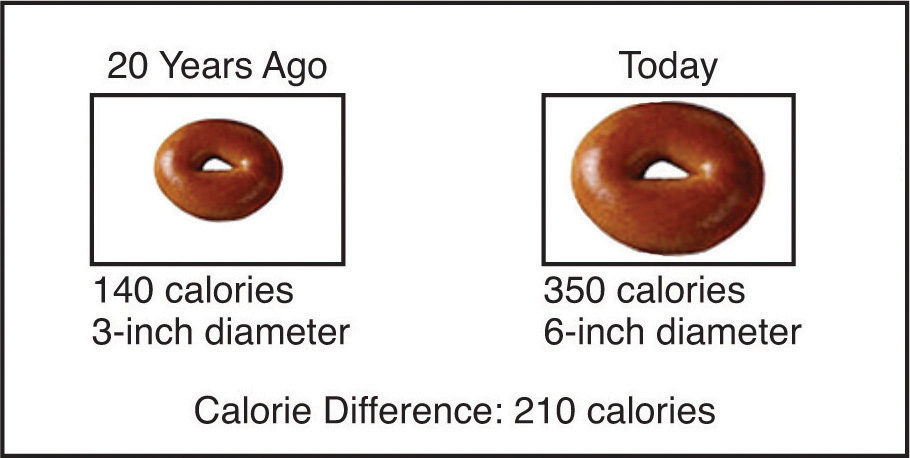
As food sizes and servings increase it is important to limit the portions of food consumed on a regular basis.
Dietitians have come up with some good hints to help people tell how large a portion of food they really have. Some suggest using common items such as a deck of cards while others advocate using your hand as a measuring rule. See Table 2.11 "Determining Food Portions" for some examples.American Cancer Society. “Controlling Portion Sizes.” Last revised January 12, 2012. http://www.cancer.org/Healthy/EatHealthyGetActive/TakeControlofYourWeight/controlling-portion-sizes.
Table 2.11 Determining Food Portions
| Food Product | Amount | Object Comparison | Hand Comparison |
|---|---|---|---|
| Pasta, rice | ½ c. | Tennis ball | Cupped hand |
| Fresh vegetables | 1 c. | Baseball | |
| Cooked vegetables | ½ c. | Cupped hand | |
| Meat, poultry, fish | 3 oz. | Deck of cards | Palm of your hand |
| Milk or other beverages | 1 c. | Fist | |
| Salad dressing | 1 Tbsp. | Thumb | |
| Oil | 1 tsp. | Thumb tip |
Video 2.5
Managing a Healthy Diet: Judging Healthy Portion Sizes
(click to see video)A dietitian shows how to compare food sizes with hands and other objects.
MyPlate Planner
Estimating portions can be done using the MyPlate Planner. Recall that the MyPlate symbol is divided according to how much of each food group should be included with each meal. Note the MyPlate Planner Methods of Use:
- Fill half of your plate with vegetables such as carrots, broccoli, salad, and fruit.
- Fill one-quarter of your plate with lean meat, chicken, or fish (about 3 ounces)
- Fill one-quarter of your plate with a whole grain such as ⅓ cup rice
- Choose one serving of dairy
- Add margarine or oil for preparation or addition at the table
Table 2.12 Meal Planning Guidelines
| Carbohydrates | Meats/Proteins | Fats | Free Foods |
|---|---|---|---|
| Choose three servings with each meal. | Choose one to three servings with each meal. | Choose one to two servings with each meal. | Use as desired. |
| Examples of one serving: | Examples of one serving: | Examples of one serving: | Examples |
|
Breads and Starches
|
|
|
Foods with less than 20 calories per serving.*
|
|
Fruits
|
|||
|
Milk
|
Key Takeaway
- Judging portion sizes can be done using your hand or household objects in comparison. It can also be done using the MyPlate guide to determine how much food is a portion for that meal.
Discussion Starter
- Why is it important to judge portion sizes properly? Explain why it can be tricky to read food labels and figure out the caloric content for one serving.
2.9 Nutrition and the Media
Learning Objective
- List at least four sources of reliable and accurate nutrition information.

Right information or wrong information? How can you know?
© Shutterstock
A motivational speaker once said, “A smart person believes half of what they read. An intelligent person knows which half to believe.” In this age of information where instant Internet access is just a click away, it is easy to be misled if you do not know where to go for reliable nutrition information. There are a few websites that can be consistently relied upon for accurate material that is updated regularly.
Using Eyes of Discernment
“New study shows that margarine contributes to arterial plaque.” “Asian study reveals that two cups of coffee per day can have detrimental effects on the nervous system.” How do you react when you read news of this nature? Do you boycott margarine and coffee? When reading nutrition-related claims, articles, websites, or advertisements always remember that one study does not substantiate a fact. One study neither proves nor disproves anything. Readers who may be looking for complex answers to nutritional dilemmas can quickly misconstrue such statements and be led down a path of misinformation. Listed below are ways that you can develop discerning eyes when reading nutritional news.
- The scientific study under discussion should be published in a peer-reviewed journal, such as the Journal of the International Society of Sports Nutrition. Question studies that come from less trustworthy sources (such as non peer-reviewed journals or websites) or that are not published.
- The report should disclose the methods used by the researcher(s). Did the study last for three or thirty weeks? Were there ten or one hundred participants? What did the participants actually do? Did the researcher(s) observe the results themselves or did they rely on self reports from program participants?
- Who were the subjects of this study? Humans or animals? If human, are any traits/characteristics noted? You may realize you have more in common with certain program participants and can use that as a basis to gauge if the study applies to you.
- Credible reports often disseminate new findings in the context of previous research. A single study on its own gives you very limited information, but if a body of literature supports a finding, it gives you more confidence in it.
- Peer-reviewed articles deliver a broad perspective and are inclusive of findings of many studies on the exact same subject.
- When reading such news, ask yourself, “Is this making sense?” Even if coffee does adversely affect the nervous system, do you drink enough of it to see any negative effects? Remember, if a headline professes a new remedy for a nutrition-related topic, it may well be a research-supported piece of news, but more often than not it is a sensational story designed to catch the attention of an unsuspecting consumer. Track down the original journal article to see if it really supports the conclusions being drawn in the news report.
When reading information on websites, remember the following criteria for discerning if the site is valid:
- Who sponsors the website?
- Are names and credentials disclosed?
- Is an editorial board identified?
- Does the site contain links to other credible informational websites? Even better, does it reference peer-reviewed journal articles? If so, do those journal articles actually back up the claims being made on the website?
- How often is the website updated?
- Are you being sold something at this website?
- Does the website charge a fee?
Trustworthy Sources
Now let’s consider some reputable organizations and websites from which you can obtain valid nutrition information.
Organizations Active in Nutrition Policy and Research
- Centers for Disease Control and Prevention (CDC)
- The Academy of Nutrition and Dietetics (AND)
- US Department of Agriculture (USDA)
- US Department of Health and Human Services (HHS)
- Dietitians of Canada
- Health Canada
- US Department of Agriculture Food and Nutrition Information Center. The USDA site http://fnic.nal.usda.gov has more than twenty-five hundred links to dietary, nutrition, diet and disease, weight and obesity, food-safety and food-labeling, packaging, dietary supplement and consumer questions sites. Using this interactive site, you can find tips and resources on how to eat a healthy diet, my Foodapedia, and a food planner, among other sections.
- The Academy of Nutrition and Dietetics (AND). The AND promotes scientific evidenced-based, research-supported food and nutrition related information on its website, http://www.eatright.org. It is focused on informing the public about recent scientific discoveries and studies, weight-loss concerns, food safety topics, nutrition issues, and disease prevention.
- Department of Health and Human Services. The HHS website, HealthFinder.gov, provides credible information about healthful lifestyles and the latest in health news. A variety of online tools are available to assist with food-planning, weight maintenance, physical activity, and dietary goals. You can also find healthful tips for all age groups, tips for preventing disease, and on daily health issues in general.
- Centers for Disease Control and Prevention. The Centers for Disease Control and Prevention (http://www.cdc.gov) distributes an online newsletter called CDC Vital Signs. This newsletter is a valid and credible source for up-to-date public health information and data regarding food, nutrition, cholesterol, high blood pressure, obesity, teenage drinking, and tobacco usage.
- Dietitians of Canada. Dietitians of Canada, http://www.dietitians.ca/, is the national professional association for dietitians. It provides trusted nutrition information to Canadians and health professionals.
- Health Canada. Health Canada, http://www.hc-sc.gc.ca/index-eng.php, is the Federal department that helps Canadians improve their health. Its website also provides information about health-related legislation.
Key Takeaway
- Reliable nutritional news will be based upon solid scientific evidence, supported by multiple studies, and published in peer-reviewed journals. Be sure the website you use for information comes from a credible and trustworthy source, such as the USDA Food and Nutrition Center, the HHS, and the CDC.
Discussion Starter
- Discuss why it is important to get information from proper and credible sources and not to rely upon single study findings.
2.10 End-of-Chapter Exercises
It’s Your Turn
- Draw a diagram that shows the role that nutrition plays in human health.
- Write three ways in which cultural, religious, and social values affect dietary eating patterns.
- Compare and contrast the Nutrition Facts label on two of your favorite foods. Make a smart choice for eating the most nutrient-dense food option. Which food did you select and why?
Apply It
- You have been hired to write a two-page article for a weekly magazine about why nutrition is important to health. Using simple terms and a good supply of photographs, create your article. Be prepared to share your project with the class.
- Record a food diary this week. At the end of the week, circle the foods that contain SoFAS. Next to each food, write a substitute food to replace it. Record a food diary next week. Be sure to eat the substitute foods you have selected to replace the foods that contained the SoFAS.
- Search the Internet for sites that claim to give you nutritional advice. Check to see who sponsors the sites and if the site is trying to sell you a product or service. Compare the information found on the sites to those recommended in this text. What similarities do you notice? What differences do you notice?
Expand Your Knowledge
-
You have just been hired at the local Boys and Girls club in an inner city neighborhood that happens to have a large high school drop-out rate. You have been put in charge of creating physical and nutritional opportunities for the community. Your goal for the first quarter is to enroll one hundred students in an exercise/nutrition program. You must develop two programs.
- Define each program and state its objectives
- Describe the ways in which the program will benefit participants
- List ways in which you will encourage enrollment
- Create a marketing flyer for each program
- You are planning a big meal for a surprise graduation party for your friend. You expect fifty guests to attend. Using the information you have learned regarding healthy eating and food portions, plan a healthful meal. Determine how much protein, vegetables, fruits, and starch you will need to purchase to feed everyone comfortably. Write down a detailed list so that you can shop and prepare your budget accordingly. Share your results with the class.
- You are a Registered Dietitian who has been asked to help a vegan patient adjust their eating habits to get more nutrients from their diet and halt unwanted weight loss. Develop a week’s worth of meals to help this person have balance in their diet.




